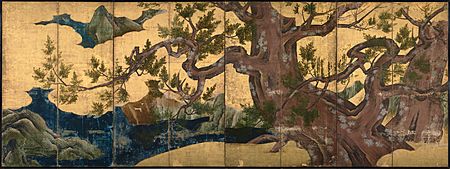Kanō Eitoku facts for kids
Kanō Eitoku (狩野 永徳, February 16, 1543 – October 12, 1590) was a famous Japanese painter. He lived during a time in Japanese history called the Azuchi–Momoyama period (1568–1600). Eitoku was a very important leader of the Kanō school of Japanese painting, which was a major art style in Japan.
Life and Works of Kanō Eitoku
Eitoku was born in Kyoto, Japan. His grandfather, Kanō Motonobu, was also a famous painter for the Japanese government. Eitoku showed great artistic talent from a young age. He learned from his grandfather, who taught him a style influenced by Chinese painting.
Eitoku worked with his father, Shōei, on many projects. One important project was painting the walls of the abbot's (leader's) rooms at Jukō-in. This was a subtemple of the Daitoku-ji Zen temple complex in Kyoto.
Eitoku painted for powerful leaders like Oda Nobunaga and Toyotomi Hideyoshi. His paintings decorated their important buildings. These included Nobunaga's Azuchi Castle and Hideyoshi's homes in Kyoto and Osaka Castle. People at the time said Eitoku was one of the most popular artists. He had many rich and powerful people asking him to paint for them. He helped the Kanō School stay very important in the art world. He made sure they always had new projects and many students helping him.
Eitoku's Painting Style
Eitoku created a special style called the "monumental style" (taiga). This style used bold, fast brushstrokes. It focused on things in the front of the painting. The subjects, like trees or animals, were often drawn very large.
This style became popular partly because Eitoku was so busy. He needed to paint quickly. It also showed the strong, brave spirit of the warlords like Nobunaga and Hideyoshi.
Sadly, many of Eitoku's works were destroyed during a time of war called the Sengoku period. But the paintings that still exist show his amazing talent. They also show how powerful and rich his patrons, Nobunaga and Hideyoshi, were. These works also show the beauty of the Azuchi-Momoyama culture.
Eitoku's paintings often show symbols like pheasants, phoenixes, and trees. For example, the pheasant is the national bird of Japan. In old stories, pheasants were believed to be messengers from the sun goddess Amaterasu.
Works
- ''Birds and flowers of the four seasons'', different panels
Images for kids
-
Chinese guardian lions (Karajishi), at the Museum of the Imperial Collections
See also
 In Spanish: Kanō Eitoku para niños
In Spanish: Kanō Eitoku para niños







